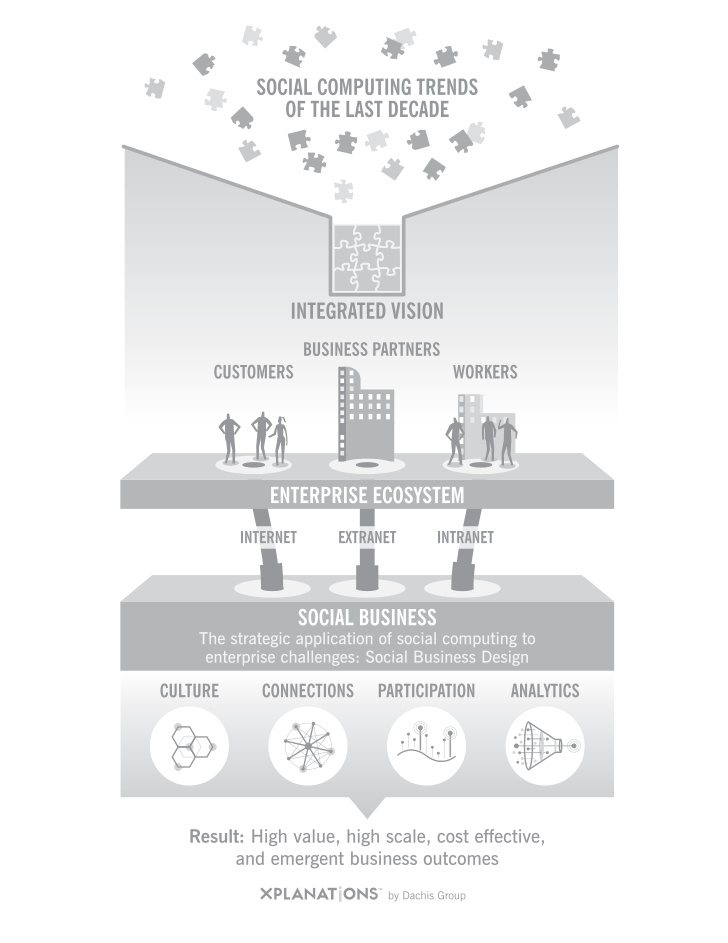WHERE WE’VE BEEN
Ten years ago, I wrote the post coining the term “social business” to describe a growth opportunity for brands beyond social media strategies at that time. Dion Hinchcliffe and I eventually wrote a book to unpack the concepts, illustrated in this graphic:

Today, “social business” has reverted back to its original meaning within the non-profit/philanthropic community, while social media for business has folded into the broader scope of digital media and marketing. But brands still need help and the current hot term for the changes needed is “digital transformation.”
The key drivers of yesterday’s “social business” underpin today’s digital transformation, having evolved over the past decade:
Technology
- Mobile devices are more powerful than ever, but Moore’s law has plateaued and Apple and other manufacturers are seeing upgrade cycles slow down. A decade ago you might have been hanging on to your Blackberry for the full physical keyboard; today you’re hanging on to your iPhone 7 or 8 because new features aren’t enticing.
- Broadband connectivity at home is widely available, leading to mass adoption of smart home technology. Searching online for knowledge used to mean opening a web browser on your desktop computer and typing words into a search engine. Now Alexa and Siri are a conversation away from completing your quest for knowledge.
- The cost of physical data storage has gotten as close to zero as profitably possible. Conference tchotchke USB drives used to be so awesome, with 4 or even 8 MB of storage. Now you can get 5 GB of free cloud storage along with your mobile device that could land an Apollo spacecraft on the moon.
Society
- Online sharing has become commonplace and some people have made a living out of the practice. Ask kids today what they want to be when they grow up and many will answer, “a YouTuber.” Social media isn’t just for sharing consumer service frustrations and conference updates; it’s how the world gets its breaking political, economic, and entertainment news.
- Millennials have not only entered the workplace; in many cases they’re running the show. The oldest millennials are almost 40 years old and carry expectations for their work and world around them, which may not align with institutions that are grounded in the values and beliefs of a different generation. The result has been cultural change; witness #MeToo and Brexit.
- “It’s not information overload…it’s filter failure.” This groundbreaking insight from Clay Shirky in 2008 describes how the internet’s minimal cost for publishing and distribution resulted in too much irrelevant information online. Now we have filter failure of an entirely different sort – our newsfeeds are finely tuned to provide very narrow streams of content that are personalised, monetised, and politicised.
Work
- When we thought through social business design in 2008, the world was bottoming out in the Great Recession. Since then, we’ve seen a historic bull market run and collateralised debt obligations have returned. Fewer businesses are operating with a burning platform but those that are – e.g. UK retailers with widespread physical presences – discover that underinvestment in social business design was a mistake, as new market entrants are more closely connected to consumers and winning in the new world.
- The open office plan has been exposed for its true purpose: cost-savings. New studies show that productivity and employee dissatisfaction drop in open floor plan offices. Startups didn’t have or want to spend money on the non-essentials, so they went with open space. Enterprises spin the open plan as collaborative and agile, but walk around an open office in New York or London and you’ll see the majority of workers wearing headphones – it’s because open offices kill productivity. Save money on hard costs, lose more on soft costs.
- Long live email! Email used to be maligned as the place knowledge goes to die, but lives on due to regulatory requirements, budget constraints, and unwillingness to change. Messaging apps like WhatsApp, Kakao, and Discord play an important supporting role, even if not officially supported by the IT department.
WHERE ARE WE NOW?
So the world has gotten more wired, consumer and employee expectations have risen, and businesses face increasing pressure from new market entrants that face lower barriers to entry. Many brands now look to digital transformation as the solution, with dreams of quantum computing, self-driving cars, and augmented realities.
But let’s be honest. All executives know their companies could get better at digital, but individual compensation schemes and corporate shareholder expectations aren’t structured to allow for proper time and investment into the hard work and deep cost of a true transformation. It’s easy to say “transformation” but the hard work and political commitment to make investments can take years to become reality.
Thus, we end up with fragmented efforts across departments, whether marketing, product, or operations: a campaign with a great sharable hook, but no CRM; a product with so much potential for connectivity, but no integration; or a system “upgrade” that takes years to implement that nobody wants to use because their consumer experiences are years ahead.
WHERE DO WE GO FROM HERE?
Getting digital transformation correct requires a commitment to change. It requires a holistic approach to people, process, and technology. WHY and HOW it happens depend largely on strategy that’s specific to situation:
- How do we create and sustain competitive advantage?
- What unique capabilities do we have?
- How can we manage financial commitments?
- What do we do and not do?
- What is our timing?
In the next ten years, no one will be surprised to see hundreds of well-known brands go into administration. Outdated business models obscure the critical changes needed to deliver the contemporary experiences that consumers, customers, and employees expect. The winners will understand how to invest early and judiciously, turn assets into advantage, and harness evolution in work, society, and technology.